Hearthstone is going on a treasure hunt in its next expansion, Kobolds & Catacombs, which is launching for the digital card game next month on PC and mobile.
This will be Hearthstone’s third expansion of the year, and the last set Blizzard will add to the game before starting a new Standard cycle in early 2018. This means that a lot of cards will be eligible in Hearthstone’s most popular mode. But Kobolds & Catacombs isn’t just 135 new cards. It’s also adding a new solo experience, Dungeon Runs, that give players without a huge collection a way to have the same experience as seasoned and money-spending fans.
The expansion is also adding new types of cards. Spellstones can become more powerful if they’re in your hand while you meet certain criteria. A simple spell that deals 2 damage to a minion for 1 mana could eventually deal 6 damage for 1 mana if you give your hero enough armor. The set is also giving every class a Legendary weapon, including ones (like Priest and Mage) that don’t normally use any.
A lot is going on with Kobolds & Catacombs. At BlizzCon, I interviewed senior game designer Peter Whalen and visual effects artist Hadidjah Chamberlin about the challenges of making such an ambitious set, especially one that comes out at the end of the Standard cycle.
June 5th: The AI Audit in NYC
Join us next week in NYC to engage with top executive leaders, delving into strategies for auditing AI models to ensure fairness, optimal performance, and ethical compliance across diverse organizations. Secure your attendance for this exclusive invite-only event.
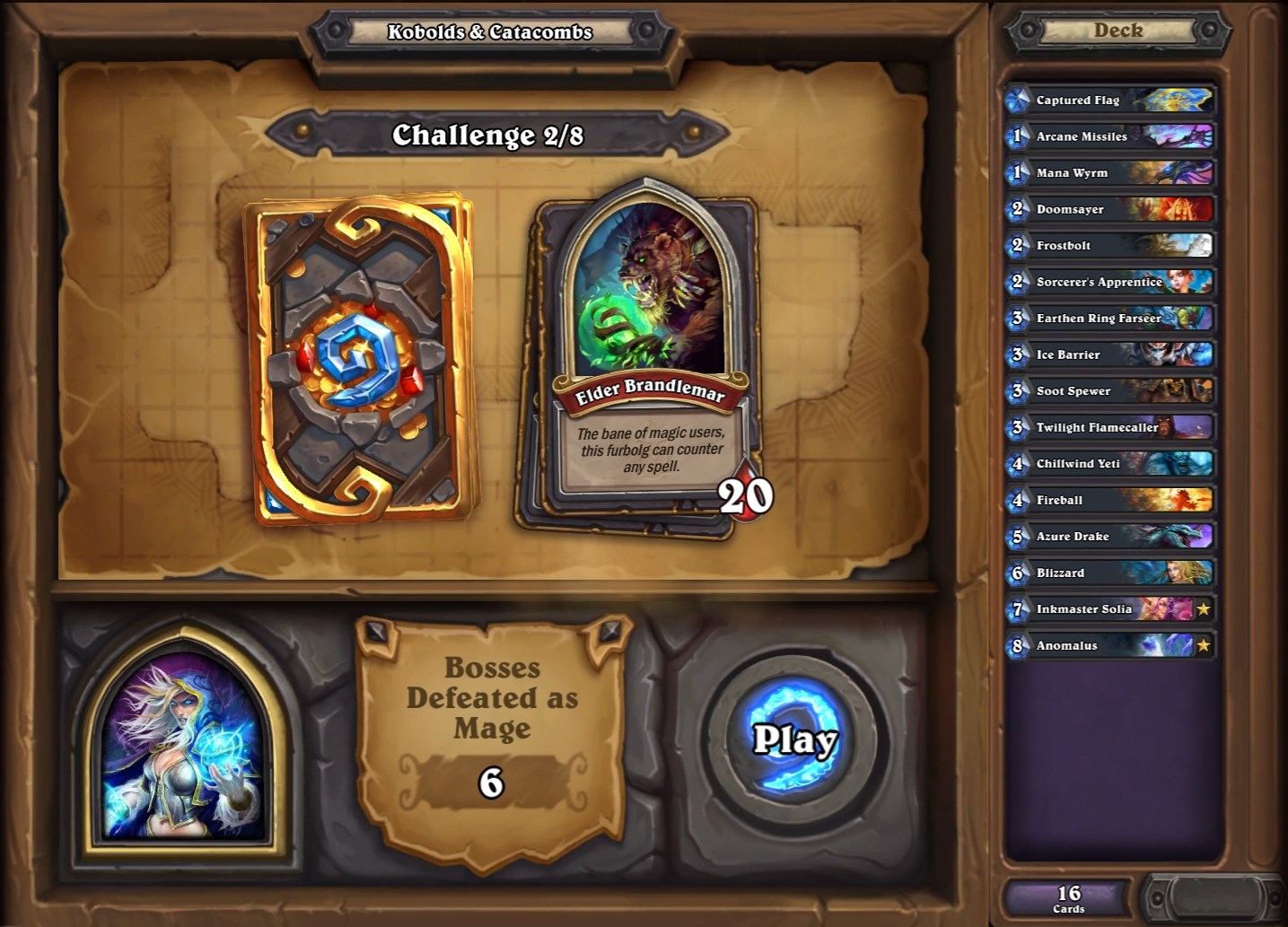
Above: Getting ready to fight a boss in Dungeon Runs.
GamesBeat: The last few expansions have focused on specific places from World of Warcraft, like Gadgetzan or Un’Goro Crater. You’re going back to a broader theme this time, as you did with Goblins vs. Gnomes, the first Hearthstone expansion that came out back in 2014.
Peter Whalen: Exactly. It’s like you said. We’ve done a lot of, here’s a place in Warcraft, let’s explore it. It’s really important for Hearthstone that we just keep changing things up, that we do different stuff every time. We sat down for this one and said, okay, we did Un’Goro, we did Icecrown, what’s something different we could do now? All right, a treasure set. A treasure set sounds pretty awesome. Then the question was figuring out the setting.
The first idea was Blingtron’s Lootapalooza, was what we were going to do. There’s all this history and backstory behind the Blingtrons. We were going to explore that, go to their secret home and figure out what was going on there and find awesome treasure. We wanted to go a bit more traditional, a bit more classic with it, as we kept exploring more.
Hadidjah Chamberlin: It’s not a very hard sell, to take a team of nerds who’ve built their whole lives around games and say, hey, we’re going to put all this in one set. Yeah, okay, that sounds amazing.
GamesBeat: When the Year of Mammoth was announced, you released a roadmap photo that included a bag of coins next to the third expansion. Was Kobolds & Catacombs planned that far in advance?
Whalen: At the time it was named “Blingtron’s Lootapalooza,” but it had a lot of the cards we have right now. If you look at the Year of the Mammoth thing, it has the coins from Blingtron’s art in the background there, because it was Blingtron’s Lootapalooza, but we already had things like the spellstone. Jasper Spellstone, that we revealed at the panel today, was literally in the set at that point. It was almost exactly the same. I don’t remember many numbers.
One small thing changed. It was one mana, deal two damage to a minion, gain three armor to upgrade, which is what it is today, and then it goes to four damage, and then six damage. The Spellstones are the cycle of nine cards in the set, one in each class, and they’re all these cool treasures you find in the dungeon that level up to do something. The Jasper Spellstone, as you gain armor, it’ll level up, and it’s a one mana removal spell. Way back when, it used to be that you had to gain the three armor in one turn. We changed it so that all the Spellstones track over the course of sitting in your hand. If you gain one armor this turn, one more next turn, one more the turn after, now it’ll upgrade into mid-level Spellstone.
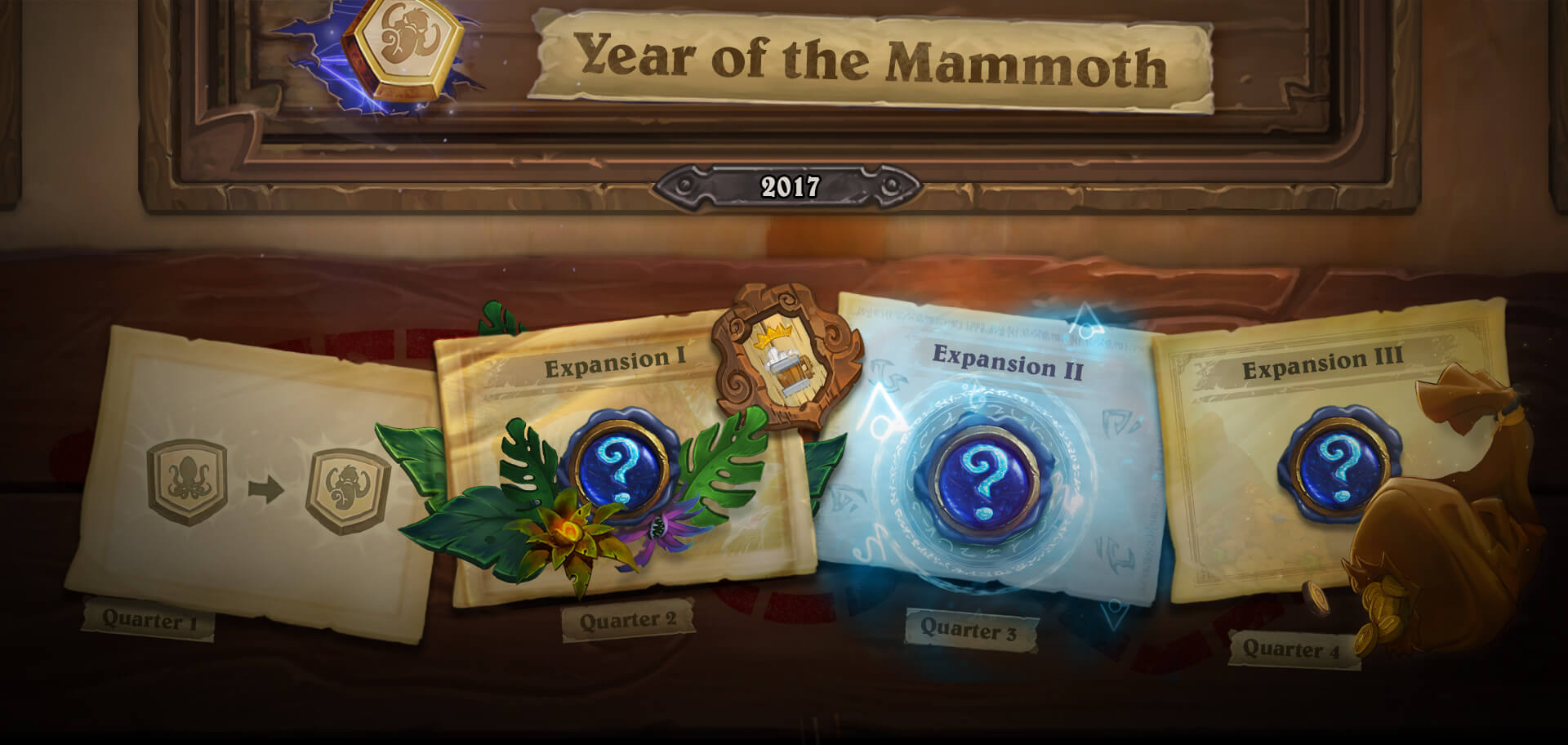
Above: Hearthstone’s 2017 timeline.
GamesBeat: We’ve seen some cards that encourage you to keep them in your hand before, but they never saw much play. Do you think this Spellstone idea will be more popular?
Whalen: It’s hard to guarantee that this is going to be a metagame card. If we knew, there’d be no exploration. If we could guarantee this would be the metagame, that would be a lot less fun. That said, Jasper Spellstone is a powerful card. One mana, deal two damage to a minion is borderline playable. We’ve seen Smite see fringe play in some decks. Arcane Shadow’s seen very fringe play in spell-based Hunter decks. But Jasper Spellstone starts off as a Smite and gets a lot better. One mana for six damage is insane. It’s an incredibly powerful effect. So yeah, I think that’s cool.
You mentioned we’ve been trying to do some of these mechanics where you hold cards in your hand for the right time to use them. That’s an important thing to call out. It’s something we’ve been trying to do more of, because it lets you play off curve. It lets you play cards that are very powerful at times you weren’t anticipating you’d need to do that. And so instead of having — it makes your turns less obvious. It lets you express your skill a bit more, because you can weave in that kind of card on future turns. It also makes it so you don’t necessarily want to play your early mana spells as early as possible.
GamesBeat: Blizzard used to be very strict with what classes could use weapons. That started to change with Medivh. But even that card only gave you a weapon as part of a Battlecry effect. Why are you OK with now just giving every class weapons?
Chamberlin: At a very high level, that’s just — when you’re crawling through a dungeon, when you’re in this classic fantasy place, weapons are a big part of that, upgrading your kit. I think thematically it’s a really good time to be doing that. Mechanically, you guys have done a really good job of keeping the weapons still feeling like they belong to their classes. There’s one per class now, whether that class has had one before or not, but you look at the cloth casters, they have Dragon Soul now. You’re not using those to go beat someone in the face, unless you’re a really, really dedicated Thoughtsteal Priest. Then maybe you can upgrade your Dragon Soul if you’re really determined to play that way.
GamesBeat: Can you use two charges of the weapon in a single turn? One time to activate its effect and another if you swing it?
Whalen: Casting the spells doesn’t take any charges off the weapon. You can do it as many times as you like.
Chamberlin: It’s more like an amulet.
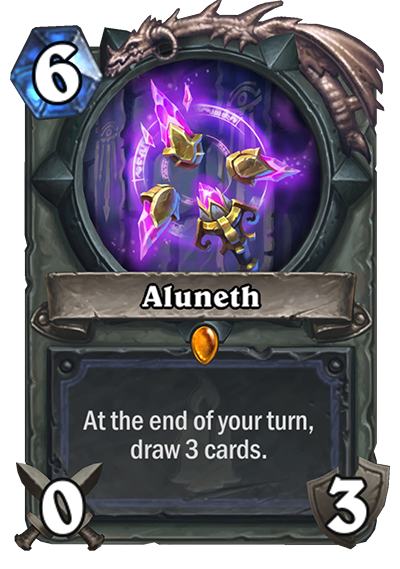
Above: Aluneth.
GamesBeat: So an Ooze meta incoming?
Whalen: Some of the weapons are better against Ooze than others.
GamesBeat: Dungeon Runs is the new single-player mode. Why are you doing something different than a typical Adventure this time?
Whalen: Basically at the same time we started working on the set. We said, this is cool. We want to go do the treasure thing. This is the classic, core idea. What is an adventure scheme that goes with it? We’d been bouncing around this idea of doing this Rogue-like dungeon-crawling game for a long time. It was just the perfect fit. Give or take maybe a year ago, we started working on it and saying, we’re going to make this happen. We’ll do it for this set. It took a huge amount of work from a bunch of people on the team, a bunch of engineering help, a bunch of work from sound, from effects, from all of the artists across the board, a bunch of the designers. It’s totally worth it. It’s so much fun.
Chamberlin: It’s so freaking fun. One of my favorite things about it is, as the — everyone’s collection is growing, especially if you’ve been in the game a long time. The dungeon runs are so easy to drop into, because it’s completely independent of your collection. There’s nothing about it that’s paid, nothing about it that’s tied to the cards you own. No matter what, you can drop in and go. We give you this little tiny deck, the equivalent of a wooden sword, and you start out smacking ten rats in a basement. And then you just go from there. It’s this really awesome run that I think is — it’s going to be really fun for everyone, regardless of how much Hearthstone they’ve played.
GamesBeat: Are there in-game rewards like Gold or Arcane Dust for doing well in the Dungeon Runs?
Whalen: There are some quests that’ll have both at the beginning, but the long-term goal is to beat the dungeon with all nine of the classes, and you’ll unlock a special card back.
GamesBeat: This seems to solve another problem. Some players complain that Hearthstone is too expensive these days. Were you thinking about that when making this free mode?
Whalen: Less that. We were more just super excited about this mode. How can we make this the most fun it could possibly be? The decision was, let’s not tie it to your collection. Let’s develop your whole deck as you go through it. It doesn’t matter what cards you own. Then the question was, at the end, should we charge people for this, charge people for runs? It makes it a lot less fun. You can’t tune the difficulty in the right place if people are investing money into it.
We wanted to make it a place where it was safe to experiment. If you get the triple Pyroblast loot pile, maybe you’ll take that and see if that deck can work. You’ll experiment with all of these crazy, weird, different ways to play. You couldn’t do that the same way if it was paid. So yeah, all of our single-player content, in Knights of the Frozen Throne and in this set, is completely free. I think that’s the right thing to do, and I’m excited about getting it into people’s hands.

Above: Starting your adventure in Dungeon Runs.
GamesBeat: A lot of the members of the community speculated that this was going to be a pirate expansion. [Laughs] Then, when you guys revealed the one card, it was Marin the Fox, and everyone thought, hey, pirates confirmed! Were you guys playing into that at all? Or did it surprise you that everyone jumped to that speculation?
Whalen: It was surprising to me. We picked Marin months ago, just because he captures the vibe of the expansion so well. It’s this awesome treasure hunter, and he’s going out and he’s going to get you some amazing loot. It’s exactly right. Treasure hunter, treasure chest, awesome loot. It was perfect. And then, yeah, we revealed him and people thought he was a pirate. He’s not even a pirate.
Chamberlin: That happened with the artist, too. Our outsourcing manager, Jeremy, when he was pitching the art for this, the artist who painted Marin — English isn’t his first language. Jeremy was trying to describe him without just saying, he’s a pirate. But everything — he’s a swashbuckler? He’s a rogue? And they’re like, okay, so he’s like a pirate? No. So he’s been “No, he’s not a pirate” since the very beginning.
GamesBeat: You have a new mechanic, Recruit. It summons a minion directly onto the battlefield. How does this work?
Chamberlin: It’s based on the minions in your deck. In the case of just Gather Your Party, you’re really hoping for something that costs a lot, and potentially may be something that has a Battlecry, or no Battlecry. You’re hoping to pull the Lich King, Ysera, or something that has a Battlecry you’d rather dodge around. It gives some really — depending on which kind of recruit it is, whether it’s the standard “pull a minion from your deck,” or “pull minions of a certain cost,” it gives people, hopefully, a lot of different ways to tune their deck to stack it in favor of pulling those minions for free, and working around different cards.
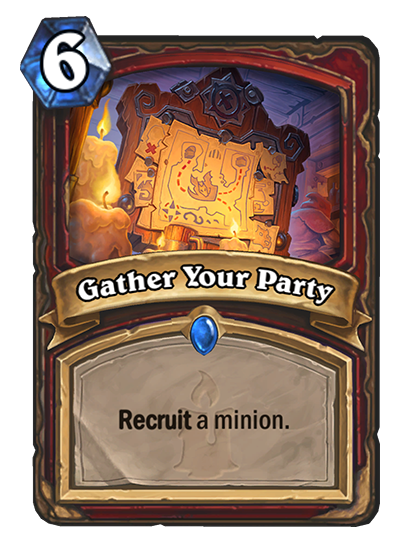
Above: Gather Your Party.
GamesBeat: It reminds me of Barnes, except you’re literally pulling a minion out of your deck this time. Barnes has been a pretty popular card. I know some people maybe don’t like the concept, because it makes luck a big factor. But a lot people like the card. Was the success of Barnes an inspiration for this mechanic?
Whalen: Not so much? We’ve learned a lot of things from Barnes. One thing that’s cool about Barnes is that he inspires you to build your deck differently. If you build a deck around Barnes, you don’t want a lot of powerful Battlecries. You want things like Deathrattle minions or things with end of turn triggers, like Ragnaros. Either Ragnaros, actually. But one of the things we learned about Barnes was that he happens very early in the game, and so when you play Barnes on turn four, it changes how the rest of the game plays out. Whether you draw Barnes early or not, especially if your deck is centered around it, that can create an experience that’s not the most positive. You feel like the game is decided very early. If your opponent has an answer that’s great for them, and if they don’t, they might just lose very quickly.
So one thing we wanted to do with Recruit was either limit how early it can happen, or restrict what the recruits can do. Things like the Guild Recruiter, a 5 mana 2/4 that recruits a little minion from your deck, the neutral card. Warriors, their thing is to have unbounded recruits. They can do Gather Your Party, Recruit any minion at all. We’re showing that first because it’s the simplest version, but it’s actually incredibly rare in the set to have this unbounded, recruit any minion at all. Even that’s pretty expensive. It costs six mana, which is meaningfully more expensive than Barnes at four.
GamesBeat: Going through the Year of the Mammoth, every set had these class Legendary cards that weren’t just minions. We had Quests, Death Knights, and now we have Legendary weapons. Was that a conscious thing? Is it something we’ll see going forward?
Whalen: A little bit of both. Giving classes two Legendaries is great for us, because it means that — neutral Legendaries, on the whole, are difficult to design. Previous sets had between 10 and 12 neutral Legendaries. One of the challenges with those is if you make them very powerful, they go in all the decks. If you make them weak, that’s not a great experience. I don’t want to open a lot of weak neutral Legendaries. And so we have to make them narrow. Narrow is great. There’s only so many narrow Legendary designs we can do per set, though. Also, there’s only so many narrow designs that work well in neutral. Some narrow designs work well in classes. If I make a neutral legendary that cares about Secrets, it only goes in three classes. That feels weird. Whereas if I make a Hunter Legendary that cares about Secrets, that’s awesome. It makes total sense. That’s part of it.
The other part is, as soon as you say, let’s make two class Legendaries — because we can make them cool, make them play up different themes in the class. We can give classes multiple things they’re trying to do in the set. Maybe each of the Legendaries push in a direction. Some of the common and rare cards will push in a different direction. That’s pretty cool. How do we differentiate the two legendary cards? We could definitely do two minions. That would be interesting. But for our first forays into doing two Legendaries, we really wanted to make them stand out and say, okay, one of them is your Legendary Quest, one of them is your Legendary Death Knight, one of them is your Legendary weapon, and then the other is your minion. It’s easy to keep them apart and understand which is which and why you’re excited about each of them independently.

Above: Knights of the Frozen Throne introduced Death Knights to Hearthstone.
GamesBeat: This is the last expansion of this cycle. The card pool is as big as it can get. Do you have to design an expansion differently when you’re thinking about that? Were there any lessons you learned from Mean Streets of Gadgetzan last year in that regard?
Whalen: There’s a danger with the last set in a cycle, making it meaningfully more powerful than the other ones. There are so many expansions out there that you need to stand out. With Kobolds & Catacombs, we hit a good balance of pushing classes in other directions, in new ways than we’ve done in the new past. Recruit is a good example. We see things like the Jasper Spellstone, which plays up an armor theme in Druid. Dragon Soul plays up more of that spell idea. We see Aluneth in that same, let’s have a mage deck that has a really low curve so you can take advantage of the fact that now you’re drawing four cards a turn. You don’t want to burn a whole bunch of cards. You just want to play through that.
By pushing in different directions from where we’ve gone in the past, that’s one of the cool things a third set can do. Okay, I don’t have to be more powerful than everything that came before. I can create new archetypes. I can let players explore in new and different ways. Another thing we try to do in the third set is play up mechanics that are about to go to Wild. It’s cool when cards go to Wild, because then the Wild pool is bigger and Wild feels more different than Standard. But at the same time, some of the cards just aren’t strong enough for Wild. There’s a lot of stuff in Wild. It’s tough to compete. It’s great if we can do something like give hand buffing a last hurrah in Standard.
GamesBeat: I saw a new card gives you three Silver Hand Recruits.
Whalen: Yeah, Drygulch Jailer.
GamesBeat: It made me think that Hand Buff Paladin might be worth another try.
Whalen: Exactly. It’s cool with hand buff cards, cool with Silver Hand Recruit cards. It actually plays interestingly in Wild, because you have things like Quartermaster. If you can hold Silver Hand Recruits in your hand, that’s pretty cool with Quartermaster. You can do some cool stuff. That’s one of the cards I’m excited about. It’s a bit unassuming, but it’s fun to play and it plays well in a bunch of archetypes.
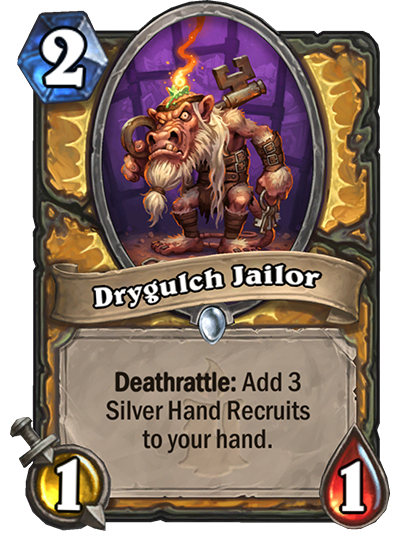
Above: Drygulch Jailer.
GamesBeat: Talking about the Standard cycle, was there ever any thought of doing it one set at a time, instead of all these expansions going away? Are you more happy with that one big event day where there’s this giant change?
Whalen: We talked about that. We’re excited about the current plan, both because it creates a huge moment, but also because it creates fewer moments where your decks don’t work. On the day of a Standard rotation, if you want to keep playing Standard, it’s pretty likely that your old decks don’t work. You have to build new ones. We wanted to keep the number of times that happens to players at a minimum. At the same time, it’s awesome to create these huge moments of swing. A whole bunch of stuff is different now. The game feels completely different. That happens less if you rotate one set at a time. It feels more gradual, rather than having these big swing moments.
GamesBeat: Coming toward the end of the Frozen Throne expansion, what do you think the team learned coming out of that? What was the reception to the cards like in general?
Whalen: People loved Death Knights.
GamesBeat: Yeah, the Death Knights seemed to be popular. A lot of them saw play but never felt unfairly powerful.
Whalen: Yeah, people love the Death Knights. They’re strong. You can build your deck around them. They create these interesting experiences. It’s also just a great fantasy. I’m playing as Thrall, but now I’m corrupted evil Thrall. That’s cool. I want an evil Thrall. The effects for the cards really play into that. They’re just a super awesome thing. That was one of the cool things where — the mission content for Frozen Throne was fantastic. The Lich King as a character was great. Doing the Lich King fight was a learning experience. We had no idea whether people would actually do that, whether they would try to do it with all nine classes. Turns out the answer is yes. A surprising number of people did it with all nine classes. That’s hard. It was tuned to be pretty difficult.

Above: Deathstalker Rexxar is the Death Knight form of Rexxar.
GamesBeat: Talking about effects, those Death Knight entrances are awesome. But how do you make equipping a Legendary weapon interesting? Weapons haven’t had much visual effects before.
Chamberlin: That was kind of — when Peter said we were doing Legendary weapons — it started out a little bit in Frozen Throne, because we have Frostmourne, Shadowmourne, [Grave Vengeance]. And then this time around we had nine of them, and I’m over there like, all right, this is a thing now. It’s different from minions in some ways, because things like Aluneth excluded, weapons don’t tend to have a lot of personality. There’s a little bit less to play into there. We tried to keep them a bit quicker.
But we did still try to make sure that it was this cool legendary moment when they come into play, like Dragon Soul or Aluneth, this very magical way, like in Frozen Throne, where a lot of the weapons were much less magical and more physical. Really having an impactful, powerful feeling. One of the conscious efforts there has been to make them a bit quicker, so you can start smacking things right away.
Whalen: Not so much with Dragon Soul or Aluneth.
Chamberlin: Right, less so with Dragon Soul. But yeah, it’s been really fun. It’s been a kind of fun challenge, still. Creating these little moments and building the visuals around that for something that’s, tone-wise, quite a bit different from minions.
GamesBeat: Sometimes we suddenly get new effects on older cards, like Deathwing or Bloodmage Thalnos. Is that something we’ll see more of? Is it difficult to find time for that when there’s three expansions a year and you’re always working on the next thing?
Chamberlin: It’s definitely something we want to keep doing. It’s still a bit of a passion project, because as you say, three expansions a year tends to keep us pretty busy. But I love getting to go back and revisit old cards, especially because a lot of these are the old-school lore characters. That’s super fun. It is one of those things where, I never know when the next one’s going to happen. It’s always, oh, I have three free days, and that’s that. But they’re always a blast to work on. It’s definitely something I like.
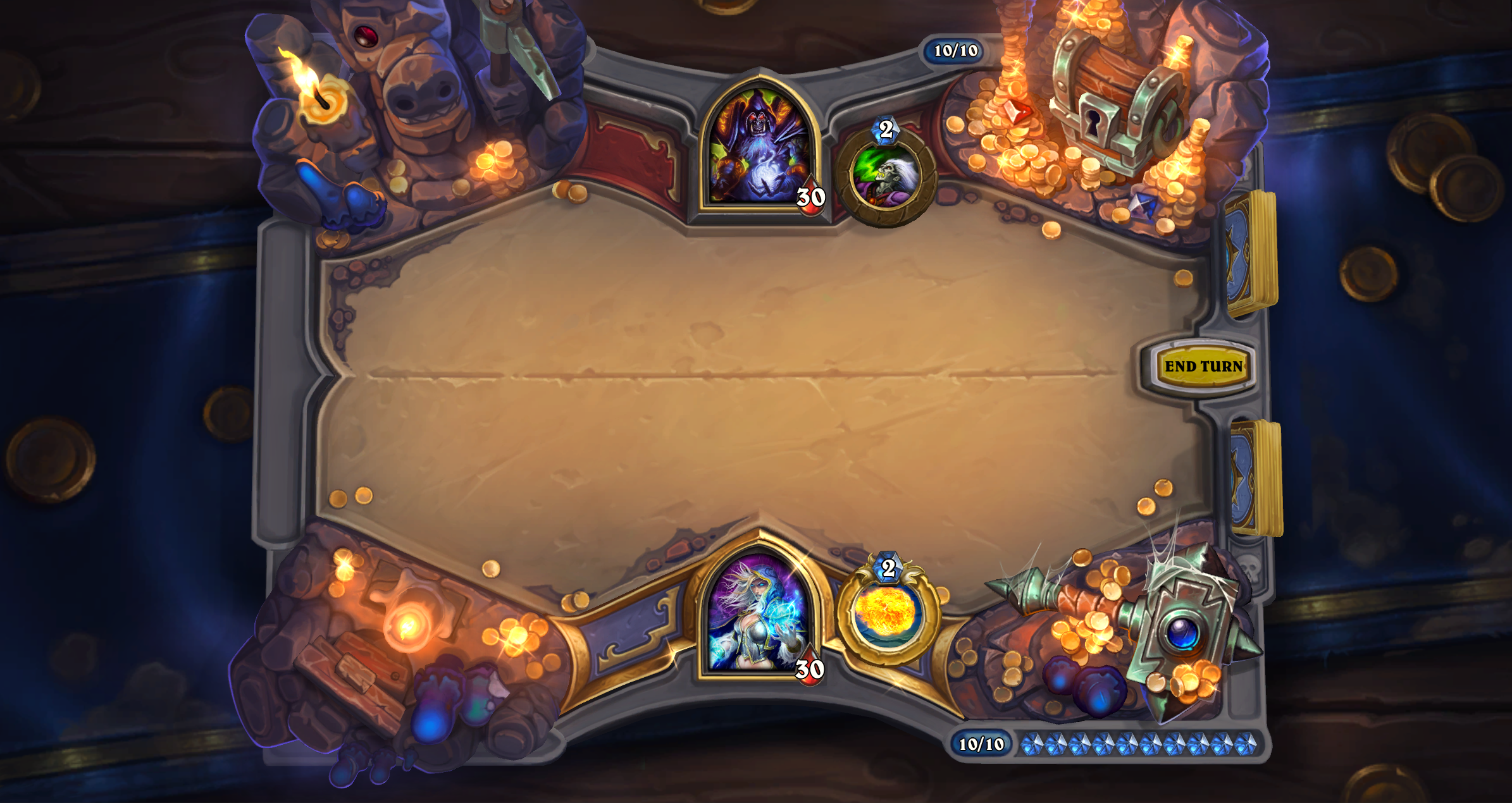
Above: The new game board for Kobolds & Catacombs.
GamesBeat: If you could do one right now, one new animation, is there a card you have in mind?
Whalen: We were just talking about this.
Chamberlin: We were. With the caveat that I have no idea when this will actually happen, and also the caveat that I have a lot of people trying to bribe me to do Edwin first —
Whalen: The whole Defias Brotherhood. They keep bribing her.
Chamberlin: I’m really excited to eventually have time to do Sylvanas. I think we could do some really cool, different stuff for her.
GamesBeat: She was such a core card, too. You saw her all the time. She has that awesome trumpet fanfare thing.
Whalen: Did you get to see the WoW (World of Warcraft) expansion cinematic?
GamesBeat: Yeah. There’s that point where she turns into a wraith-ey thing, and I was terrified. It was awesome.
Chamberlin: By the time we saw the cinematic for the first time, I’d been musing on Sylvanas anyway, and then I saw that and I was like, ahhh! That was pretty cool to see.
GamesBeat: Speaking of VanCleef, when I think about dark places, that name kind of comes up. Are we done with the VanCleefs in Hearthstone? Will we be seeing them some more? Isn’t there a Vanessa VanCleef out there somewhere?
Whalen: There is a Vanessa VanCleef. I wrote a pitch a long time ago for an expansion that had her in it. Anything is possible.


